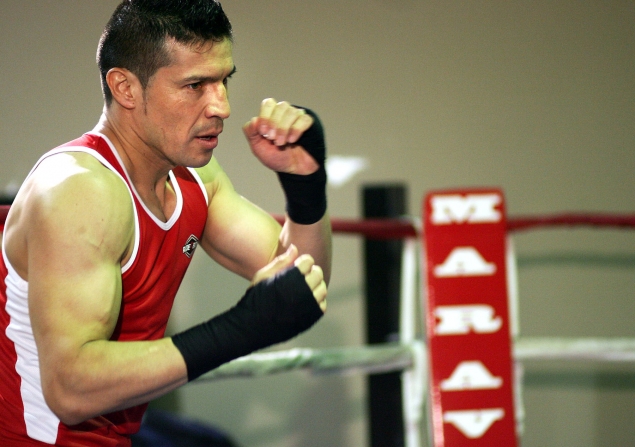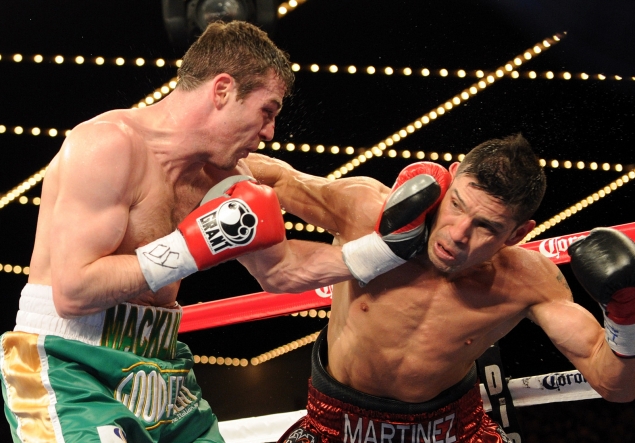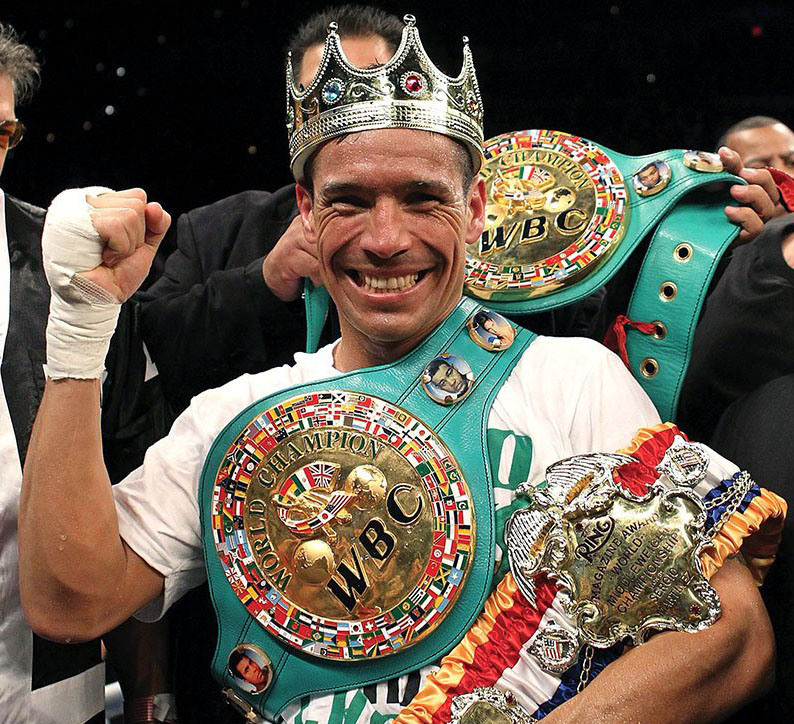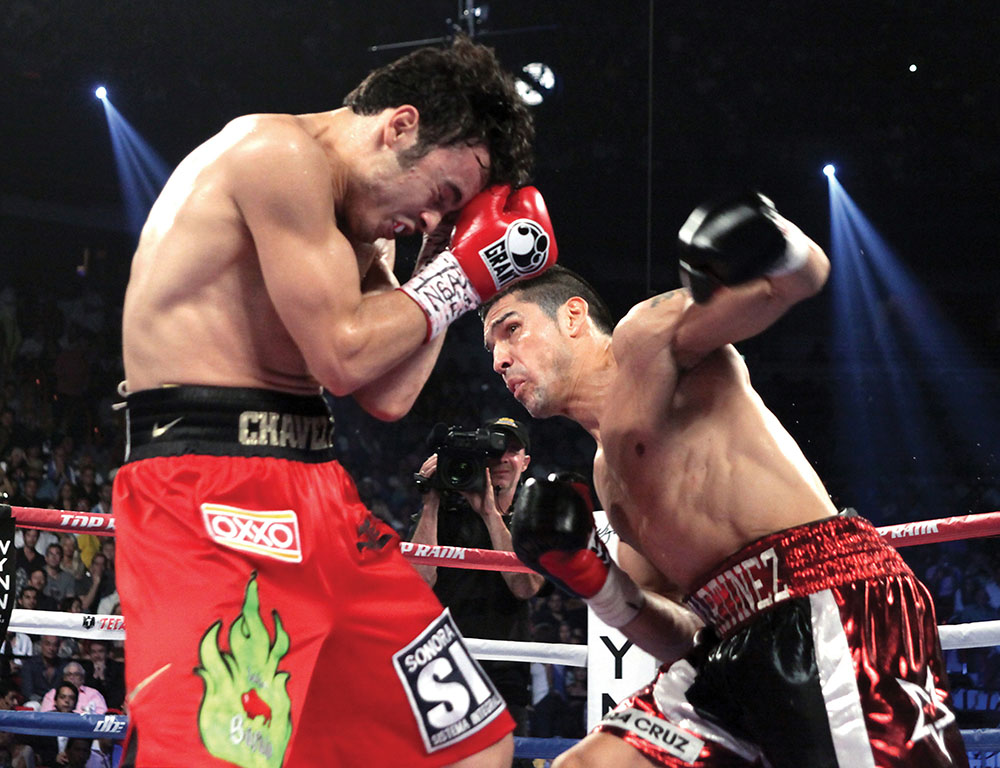Greatest Hits: Sergio Martinez

This feature originally appeared in the February 2021 issue of The Ring, which is available for purchase at The Ring Shop.
THE FORMER MIDDLEWEIGHT CHAMPION FROM ARGENTINA LOOKS BACK AT A LEGACY STILL IN THE MAKING
Sergio Martinez’s journey took him across an ocean and into his mid-30s before the southpaw with matinee idol looks was able to show everyone what he had long known: that he was one of the best pound-for-pound fighters in the world.
Martinez grew up in the outskirts of Buenos Aires, Argentina, and was the middle child of three. His mother, Susana, was a housewife and his father, Hugo, was a metalworker.
“We were a poor family, living in a very small house in Quilmes (about 11 miles from the capital city),” Martinez told The Ring through Oscar Zardain. “I left school at 14 because of the economic situation at home to help my father in his work.
“Boxing was always around my family. My uncle Rubén Paniagua had a boxing gym in Quilmes and he was a pro in the 1980s. We were good boxing fans, but I was playing soccer.
“At age 20, I started to box only to improve my physical condition. My first day at a boxing gym was May 2, 1995. I tried it once and I was hooked. I have not stopped ever since.”

Matthew Macklin at war with Martinez.
Martinez competed as an amateur at the 1997 World Championships in Budapest, Hungary, but lost his second bout to Adrian Diaconu, who would go on to briefly hold the WBC light heavyweight title. Martinez turned professional that same year.
The skilled boxer-puncher won 16 of his first 17 outings, the lone blemish being a draw in his third fight. He made his American debut against a young Antonio Margarito on the undercard of Marco Antonio Barrera-Erik Morales in February 2000. Although Martinez was stopped in seven rounds, it was a valuable learning curve for him.
“The Margarito fight was the key,” he said. “This loss taught me that I was not ready to fight at the highest level and that I needed to improve a lot of things, like my physical condition, my team and also my management.”
He regrouped and claimed the national welterweight title before he was prompted by the situation in Argentina to make a life-altering decision.
“In 2002, I decided to immigrate to Europe,” he explained. “Argentina was suffering a terrible economic crisis, and I needed to work. I was hungry – the boxing was a separate thing. I moved to Spain because the language [was the same as in Argentina] and I started to work in gyms or as security in bars and discos.”
Martinez won four low-key fights in Spain and was offered a fight against well-respected Brit Richard Williams in England. In successive fights, he upset Williams by unanimous decision, stopped Adrian Stone and then stopped Williams in a rematch. The wins should have set Martinez on the right path. Instead, he found himself returning to Spain and relative obscurity.
“Nobody wanted to fight me after the U.K. victories,” he said. “I suffered this problem all my life. I am very grateful to Lou (DiBella, his promoter) and Sampson (Lewkowicz, his manager) for helping me in this part of my career; they put a lot of money and hopes on me.”
Fighting on DiBella’s cards, things began to thaw in 2008 when Martinez stopped Alex Bunema for the WBC interim junior middleweight title, but misfortune continued to plague the Argentine. Somehow the judges controversially robbed him against Kermit Cintron (D 12) in 2009. He then suffered further heartache in a majority decision loss to Paul Williams later that year.
Then came his big break. When Williams was unable to face Ring/WBC/WBO middleweight champion Kelly Pavlik, Martinez stepped into the breach. It was an opportunity “Maravilla” (“The Marvel”) wasn’t going to pass up, and he won a hard-fought unanimous decision.
“It was a dream come true,” he said proudly. “To be lineal middleweight champion like Marvin Hagler, Sugar Ray Robinson or Carlos Monzón, a real legend in my country. Also, I was (eventually) No. 3 pound-for-pound after (Floyd) Mayweather and (Manny) Pacquiao. I entered into the history of boxing like a king.”

(Photo by Al Bello/Getty Images)
Martinez went on to make six successful defenses of the 160-pound throne, including an unforgettable one-punch Knockout of the Year against Williams and a valiant final-round stand against Julio Cesar Chavez Jr., before injury and Father Time caught up with him and he yielded his position to Miguel Cotto in June 2014.
Martinez decided to retire from boxing but, like many before him, the lure of the sport proved too powerful for him to ignore. In August, the now-45-year-old returned, stopping journeyman Jose Miguel Fandino in seven rounds.
“[I want to] check my feelings in the ring and feel the punches again,” Martinez told The Ring after making the decision to try a comeback. “Then we will see [what I can do].
“Boxing is my life. Everything was wrong in my last fight against Cotto: training camp, the injuries, my knee. Now I am feeling really good and my knees are better. All these years of rest were very good for my knees and elbows.”
Martinez lives with his girlfriend in Madrid, Spain. He owns Maravilla Promotions and stays busy doing corporate motivational speeches and working on his stand-up comedy show.
Here’s what he had to say about six of his most memorable nights in the ring:
ANTONIO MARGARITO
February 19, 2000, Mandalay Bay, Las Vegas • Titles: None
“Las Vegas is an amazing city, especially for a kid who has never been out of Argentina – except one time before in Hungary with the national amateur team. The first day was a shock. The night I fought Margarito, I did not think he had his gloves loaded. He was the better fighter that night and he was better-prepared than I was. I have no regrets, and it was early in my career; I have become a better fighter because of it. Just after the fight, an Argentine reporter from TV asked me about my thoughts and I told him, ‘I will be back to Las Vegas better and stronger than tonight.’ Twelve years later, I was there beating [Julio Cesar Chavez Jr.]. After the Margarito fight, I was sad, but of course I found a place in the middle of the crowd to see Morales-Barrera, one of the best fights in the history of boxing. Years after the fight, when I was based in the States, I found out that the purse of [the Margarito fight] was $25,000, but I received only $900. This is the perfect summary of the experience. The fight was a disaster. I had no team, I had no plan A or B … or Z. What happened had to happen; justice was done. It would have been unfair for me to beat Margarito – impossible and unfair.”
Result: Margarito TKO 7
RICHARD WILLIAMS 2
April 17, 2004, King’s Hall, Belfast, Northern Ireland • Titles: None
“The most important victory was against Richard Williams. I was in a very bad moment – without money, without legal papers as an immigrant in Spain – and that victory showed me that I was ready for the big fights. I was fighting for my life and my future. The three fights [in England, versus Williams twice and Adrian Stone,] are my favorite fights and the most important part of my career. In the first Williams fight, he knocked me down, but my father was in the crowd; I saw him and I thought to myself, ‘Get up. Your moment is now or never.’ I knew Williams was defeated before starting [the second fight]. Taking this fight was a big mistake for his team; I was better than the first fight and I won easily. Williams was a great fighter, but after our first fight he was never the same again.”
Result: Martinez TKO 9

Martinez vs. Kelly Pavlik (AP Photo/Tim Larsen)
KELLY PAVLIK
April 17, 2010, Boardwalk Hall, Atlantic City, New Jersey • Titles: Ring/WBC/WBO middleweight
“I was not the favorite. Pavlik was a superstar and the lineal middleweight champion, and I am small for 160. The people started to know me after the first fight against Paul Williams, but mostly I was an unknown fighter. My initial idea was to win all the rounds, because I was the challenger. The fight was hard. He knocked me down in the seventh round and I could feel all his power; he was big and strong. I had to adapt my fight game to the knockdown and the cuts that he suffered. Thanks to my southpaw stance, my footwork and the strategy, I won that fight. It all changed around me. I was a champion before the fight at 154, but after the victory over Pavlik, I became a superstar. A lot of people and journalists started to ask, ‘Who is Maravilla?’ It was hard, because I am a quiet person, but I understood it was necessary to speak to the press, do TV interviews, media days and photo sessions for the business.”
Result: Martinez UD 12
PAUL WILLIAMS 2
November 20, 2010, Boardwalk Hall, Atlantic City, New Jersey • Titles: Ring/WBC middleweight
“I was new on this level and Williams was my first serious test. I learned from that [first fight] how to fight against the top-class fighters. After the fight, I corrected some mistakes in my training camps. If you watch the second fight again, you can see that I threw and landed the same punch six times before the final one. Paul was a tough fighter with a tremendous iron chin, but he was not hard to hit; his defense was not the best in the game. It was just about chopping down the tree. I hurt him in the first fight and I knew that in the rematch I could do it again. Being objective, yes, this knockout was the most important punch of my career.”
Result: Martinez KO 2

Martinez survived a late knockdown to reclaim the WBC middleweight belt when he defeated Julio Cesar Chavez Jr. by a unanimous decision. Photo credit by JOHN GURZINSKI/AFP/Getty Images
JULIO CESAR CHAVEZ JR.
September 15, 2012, Thomas & Mack Center, Las Vegas • Titles: Ring/WBC middleweight
“Fight week and fight day were a dream come true, but the year-and-a-half before were a nightmare. I did not understand the situation, how the WBC took my belt in an office. I am very grateful to Lou and Sampson for the help that they gave me. I [recaptured the WBC title] that night not because I won 11½ rounds, I was the champion because I got up in the last round. I was aware. In fact, the first thing that I did was look to my corner and make a gesture to them to indicate that I was fine. The big problem was my knee; I had a lot of problems during the training camp, and after the knockdown I felt my knee was not good. I had to have surgery after the fight. It’s the champion’s way [to fight with injuries]. Boxing is the hardest sport. It’s the hurt business. If you are not ready for this, look for another activity.”
Result: Martinez UD 12
MARTIN MURRAY
April 27, 2013, José Amalfitani Stadium, Buenos Aires • Titles: Ring/WBC middleweight
“The training camp was not the best, my knees were in a very bad condition and I think that we made a lot of mistakes for this fight – and the next (Cotto), too. I was very happy, very excited. We (Argentines) are crazy about sports, and all the people were cheering all the time. The real number of people was very close to 50,000, and the fight was broadcast on two public channels at the same time. The weather was not a problem; it was a little cold, but with this kind of crowd you are in a special atmosphere. Fighting in the middle of an electric storm was epic. I was in no position to clearly win the fight because of my injuries and training camp, and Murray was not ready to win a fight for the title in front of 50,000 fans. To be honest, I think that I won the first half of the fight and also the championship rounds. Martin did well, a very good competitive fight. He is strong and a very good fighter, but I still think that I was the fair winner. The key was the last two rounds, in my opinion.”
Result: Martinez UD 12
Oscar Zardain helped coordinate and translate this feature. The Ring appreciated his assistance.
Questions and/or comments can be sent to Anson at [email protected] and you can follow him on Twitter @AnsonWainwright















